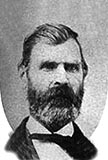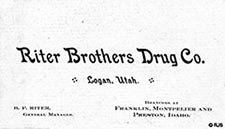Early Commerical Institutions ~ Index
Establishment banks, mercantile houses, drug stocks and doctors in Cache Valley.

Hezekiah Thatcher was the pioneer of commerce in Cache Valley as well as the founder of the principal manufacturing interests. He brought the first assortment of general merchandise into the valley as early as the spring of 1860. The men who were employed by him to construct the Union Saw and Grist Mills, the millrace, houses, barns and sheds were paid in merchandise. As merchandise was very scarce it was more acceptable to the workers than the money.
As the population increased, William Jennings and William S. Godbe, each opened a small store in Logan and they drew their supplies from their larger stocks in Salt Lake City. All classes of imported goods were sold at extremely high prices and these prevailed for a number of years. Contrasting the prices and conditions of the present with those of the past, it is difficult to realize how it was possible for the early settlers to earn a living especially for a number of years, as there was no market for the products of the country.
The commercial prosperity of Cache Valley had its commencement immediately following the development of the wonderfully rich placer mines of Montana, from which came annually thousands of dollars in exchange for the products here. A ready cash market was created and businessmen wisely and promptly laid the foundations for permanent prosperity. Not only did this new market furnish gold for the farm products, but many valuable wagons and teams came to the settlers in exchange for flour, grain, garden and dairy products.
The first mercantile institution of any consequence was founded by Hezekiah Thatcher and William H. Shearman, known as Shearman and Thatcher. They purchased the stock of Godbe and joined it with that of Hezekiah Thatcher. Jenings continued in business and a littler later Robins and Goodwin started a store. An enterprising Jew named Goldberg also started a store and remained in Logan for several years.

Shearman and Thatcher dissolved partnership and Moses Thatcher, Sr. joined his father and a firm was organized known as Thatcher and Son, with Moses Thatcher, Sr. as the manager. Moses Thatcher, Sr. was a keen business man and with the construction of the Union Pacific railroad lines, business was stimulated and this firm at once took the lead in reducing prices for merchandise and advancing the price for produce.
With the idea of cooperation injected into every phase of community life and in the colonization of all the settlements of the valley, it was but natural that the cooperative movement should be extended to merchandising where the profits would accrue to all and not to a few. The idea was agitated and a call was made from Apostle Ezra T. Benson and Bishop Peter Maughan for Cooperative Institutions. The firm of Thatcher and Son was the first to respond and a new cooperative firm known as the Logan Co-operative Mercantile and Manufacturing Institution was organized with Apostle Ezra T. Benson as president, Peter Maughan vice-president, William H. Searman, secretary and Moses Thatcher, Sr., superintendent. Subsequently the firm bought out Jennings and absorbed Robbins and Goodwin and controlled the commercial affairs of the city. Besides wholesaling and retailing general merchandise, it manufactured leather, harness, boots and shoes. Later, in compliance with the wish of President Brigham Young, the Logan Co-operative Mercantile and Manufacturing Institution became a part of the Zion's Co-operative Mercantile Institution and was known as the Logan branch. Its trade was widely extended under the able management of Moses Thatcher, Sr. Protection to buyers, uniform prices, small profits and quick sales were the rules while the credit system was discouraged. For years the Logan branch was the principal commercial institution in northern Utah.
To Moses Thatcher, Sr. belongs the credit of organizing the first Board of Trade, what today would be called a Chamber of Commerce. The Cache Valley Board of Trade was organized with representative businessmen from the various settlements and the bishops of the wards. The Board prevented hurtful competition, unwise reduction of prices on farm products and the best markets were sought to bring the producers and consumers in closer relation.

Dr. O.C. Ormsby, a young physician and a graduate of the Rush Medical College, was the first to enter the drug business in Logan. Upon invitation, he came from Brigham City to Logan with a small stock of drugs. Very shortly he built up a good business and founded the Pioneer Drug Company, the first drug store in the valley. In 1878, the firm was changed to the name of Ormsby & Riter and Mr. Benjamin F. Riter moved from Salt Lake City to Logan and became Dr. Ormsby's working companion. Later the Riter brothers took over the interest of Dr. Ormsby and the firm became known as Riter Brothers. In 1891, the partnership was incorporated and became known as the Riter Brothers Drug Company.
A substantial building was erected and was occupied by the firm until 1929. This company was one of the early landmarks of Logan and up until 1929 was the only firm along Main Street that had retained its first location of the early period. For years it was the leading drug business in northern Utah and southern Idaho, doing a wholesale as well as retail business with branches houses.
Thomas B. Cardon settled at Logan in 1867 and established the first watch making and jewelry store in the valley where Ruchti, the tailor was located, west of First North. In 1872 he added to it photography and a fine art gallery. Being of an enterprising nature he branched out in 1881, erected a large three-story cut stone and brick building, now occupied by the Logan Hardware Company. It was the first business house of this size in the city. Here also the Thatcher Bank opened its banking establishment, the first in the valley.

Mr. Cardon by nature was an artist and possessed an artistic temperament. He was born in Italy, the land of art and genius, and this native instinct was brought into his profession as photographer and jeweler. For years his photographs adorned many of the homes in the valley and many of his watches are still in evidence. That this native artistic disposition was transmitted to his children is very evident from the appearance of the business houses represented by them in the city at present.
Doctors Stover and Hitchock were among the first dentists to locate at Logan and they built up a good practice and were two of the leading dentists for years. Some of their patients came from as far north as Dillon, Montana.
Along with the establishment of the mercantile houses in the city and valley and the development of the farms and industries, a strong banking institution became necessary, where exchanges and remittances of money could be made and financial help be given to the people for the more rapid development of the agricultural resources and commerce of the valley. As a result of this demand, the first banking institution in the valley, known as the Thatcher Brothers Co., was founded by George W. Thatcher, Sr. It was organized as a company and started business January 1st, 1883, in a room of Thomas B. Cardon's store on Main Street. Mr. H.E. Hatch was the cashier. The capital of the company was $60,000.00 and the next year it was increased to $75,000.00.